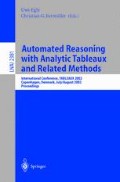Abstract
The “planning as satisfiability” paradigm, which reduces solving a planning problem P to the search of a model of a logical description of P, relies on the assumption that the agent has complete knowledge and control over the world. This work faces the problem of planning in the presence of incomplete information and/or exogenous events, still keeping inside the “planning as satisfiability” paradigm, in the context of linear time logic.
We give a logical characterization of a “conditioned model”, which represents a plan solving a given problem together with a set of “conditions” that guarantee its executability. During execution, conditions have to be checked by means of sensing actions. When a condition turns out to be false, a different “conditioned plan” must be considered. A whole conditional plan is represented by a set of conditioned models. The interest of splitting a conditional plan into significant sub-parts is due to the heavy computational complexity of conditional planning.
The paper presents an extension of the standard tableau calculus for linear time logic, allowing one to extract from a single open branch a conditioned model of the initial set of formulae, i.e. a partial description of a model and a set of conditions U guaranteeing its “executability”. As can be expected, if U is required to be minimal, the analysis of a single branch is not sufficient. We show how a global view on the whole tableau can be used to prune U from redundant conditions. In any case, if the calculus is to be used with the aim of producing the whole conditional plan off-line, a complete tableau must be built. On the other hand, a single conditioned model can be used when planning and execution (with sensing actions) are intermingled. In that case, the requirement for minimality can reasonably be relaxed.
Access this chapter
Tax calculation will be finalised at checkout
Purchases are for personal use only
Preview
Unable to display preview. Download preview PDF.
References
S. Cerrito and M. Cialdea Mayer. Using linear temporal logic to model and solve planning problems. In F. Giunghiglia, editor, Proceedings of the 8th International Conference on Artificial Intelligence: Methodology, Systems, Applications (AIMSA’98), pages 141–152. Springer, 1998.
M. Cialdea Mayer, A. Orlandini, G. Balestreri, and C. Limongelli. A planner fully based on linear time logic. In S. Chien, S. Kambhampati, and C.A. Knoblock, editors, Proc. of the 5th Int. Conf. on Artificial Intelligence Planning and Scheduling (AIPS-2000), pages 347–354. AAAI Press, 2000.
A. Cimatti, M. Roveri, and P. Traverso. Strong planning in non-deterministic domains via model checking. In Proc. of the International Conference on AI Planning and Scheduling (AIPS’98). AAAI Press, 1998.
A. Finzi, F. Pirri, and R. Reiter. Open world planning in the Situation Calculus. In Proceedings of the 7th Conference on Artificial Intelligence (AAAI-00) and of the 12th Conference on Innovative Applications of Artificial Intelligence (IAAI-00), pages 754–760. AAAI Press, 2000.
G. L. J. M. Janssen. Logics for Digital Circuit Verification. Theory, Algorithms and Applications. CIP-DATA Library Technische Universiteit Eindhoven, 1999.
H. Kautz and B. Selman. Planning as satisfiability. In B. Neumann, editor, 10th European Conference on Artificial Intelligence (ECAI), pages 360–363. Wiley & Sons, 1992.
H. Kautz and B. Selman. Pushing the envelope: Planning, propositional logic, and stochastic search. In Proc. of the 13th National Conference on Artificial Intelligence (AAAI-96), pages 1202–1207. AAAI Press / The MIT Press, 1996.
H. Levesque. What is planning in the presence of sensing? In Proc. of the 13th National Conference on Artificial Intelligence, AAAI-96, pages 1139–1146. AAAI Press, 1996.
M. A. Peot and D. E. Smith. Conditional nonlinear planning. In J. Hendler, editor, Proc. of the First International Conference on Artificial Intelligence Planning Systems, pages 189–197. Morgan Kaufmann, 1992.
M. Pistore and P. Traverso. Planning as model checking for extended goals in non-deterministic domains. In Proc. IJCAI’01. AAAI Press, 2001.
L. Pryor and G. Collins. Planning for contingencies: a decision-based approach. Journal of Artificial Intelligence Research, 4:287–339, 1996.
R. Reiter. The frame problem in the situation calculus: A simple solution (sometimes) and a completeness result for goal regression. In V. Lifschitz, editor, Artificial Intelligence and mathematical theory of computation: Papers in honor of John McCarthy, pages 359–380. Academic Press, 1991.
J. Rintanen. Constructing conditional plans by a theorem-prover. Journal of Artificial Intellingence Research, 10, 1999.
A. P. Sistla and E. M. Clarke. The complexity of propositional linear temporal logics. Journal of the ACM, 32(3):733–749, 1985.
D. E. Smith and D. S. Weld. Conformant Graphplan. In Proc. of the 15th National Conference on Artificial Intelligence (AAAI-98), pages 889–896, 1998.
P. Wolper. The tableau method for temporal logic: an overview. Logique et Analyse, 28:119–152, 1985.
Author information
Authors and Affiliations
Editor information
Editors and Affiliations
Rights and permissions
Copyright information
© 2002 Springer-Verlag Berlin Heidelberg
About this paper
Cite this paper
Mayer, M.C., Limongelli, C. (2002). Linear Time Logic, Conditioned Models, and Planning with Incomplete Knowledge. In: Egly, U., Fermüller, C.G. (eds) Automated Reasoning with Analytic Tableaux and Related Methods. TABLEAUX 2002. Lecture Notes in Computer Science(), vol 2381. Springer, Berlin, Heidelberg. https://doi.org/10.1007/3-540-45616-3_6
Download citation
DOI: https://doi.org/10.1007/3-540-45616-3_6
Published:
Publisher Name: Springer, Berlin, Heidelberg
Print ISBN: 978-3-540-43929-5
Online ISBN: 978-3-540-45616-2
eBook Packages: Springer Book Archive

